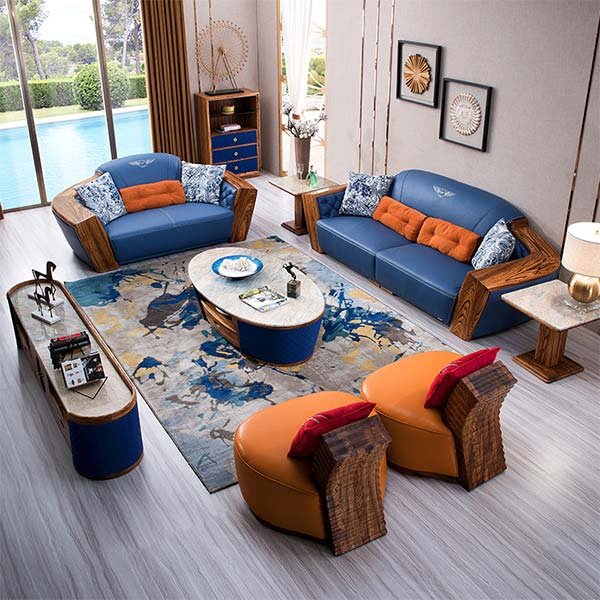“Embrace Nature’s Beauty, Embrace Sustainable Living”
Sustainable Sourcing: Exploring the use of responsibly harvested wood for furniture production
Sustainable Sourcing: Exploring the use of responsibly harvested wood for furniture production
In recent years, there has been a growing trend towards eco-friendly design, with consumers becoming more conscious of the environmental impact of their purchases. One area where this trend is particularly evident is in the use of responsibly harvested wood for furniture production. This article will explore how wooden furniture is shaping the future of eco-friendly design and the importance of sustainable sourcing.
Wood has long been a popular material for furniture due to its durability, versatility, and natural beauty. However, the demand for wood has led to deforestation and habitat destruction in many parts of the world. To address this issue, furniture manufacturers are increasingly turning to responsibly harvested wood.
Responsible harvesting involves carefully managing forests to ensure the long-term health and sustainability of the ecosystem. This includes planting new trees to replace those that are cut down, protecting wildlife habitats, and minimizing the use of harmful chemicals in the production process. By sourcing wood from responsibly managed forests, furniture companies can help preserve biodiversity and reduce their carbon footprint.
One example of sustainable sourcing is the use of FSC-certified wood. The Forest Stewardship Council (FSC) is an international organization that sets standards for responsible forest management. FSC-certified wood comes from forests that have been independently verified to meet these standards. By choosing furniture made from FSC-certified wood, consumers can be confident that they are supporting sustainable practices.
Another approach to sustainable sourcing is the use of reclaimed wood. Reclaimed wood is salvaged from old buildings, barns, and other structures that are no longer in use. By repurposing this wood, furniture manufacturers can reduce the demand for new timber and prevent valuable resources from going to waste. Reclaimed wood also adds a unique character and history to furniture pieces, making them even more desirable for eco-conscious consumers.
In addition to responsible harvesting, the production process itself plays a crucial role in the eco-friendliness of wooden furniture. Many manufacturers are adopting sustainable practices such as using non-toxic finishes and adhesives, minimizing waste, and reducing energy consumption. These efforts not only benefit the environment but also contribute to the overall quality and longevity of the furniture.
The shift towards eco-friendly design is not only driven by consumer demand but also by government regulations and industry standards. Many countries have implemented laws and regulations to promote sustainable sourcing and discourage illegal logging. In addition, organizations such as the Sustainable Furnishings Council (SFC) provide certifications and resources to help furniture companies adopt sustainable practices.
As the demand for eco-friendly furniture continues to grow, the future of wooden furniture looks promising. By embracing responsible harvesting and sustainable production practices, furniture manufacturers can meet the needs of environmentally conscious consumers while also contributing to the preservation of our planet’s natural resources.
In conclusion, the use of responsibly harvested wood is shaping the future of eco-friendly design in the furniture industry. Sustainable sourcing practices such as FSC certification and the use of reclaimed wood are becoming increasingly popular. Coupled with sustainable production processes, these practices help reduce deforestation, protect wildlife habitats, and minimize the environmental impact of furniture production. As consumers become more aware of the importance of sustainability, the demand for eco-friendly wooden furniture is expected to continue to rise.
Innovative Designs: Showcasing unique and creative wooden furniture designs that prioritize eco-friendliness
Wooden furniture has long been a staple in interior design, but in recent years, it has taken on a new role as a driving force behind eco-friendly design. With a growing emphasis on sustainability and environmental consciousness, innovative designers are showcasing unique and creative wooden furniture designs that prioritize eco-friendliness.
One of the most exciting aspects of these innovative designs is the use of reclaimed wood. By repurposing old wood from buildings, barns, and other structures, designers are able to give new life to materials that would otherwise go to waste. This not only reduces the demand for new wood but also helps to preserve forests and reduce deforestation. Additionally, reclaimed wood often has a unique character and history that adds a sense of authenticity and charm to the furniture.
Another trend in eco-friendly wooden furniture design is the use of sustainable wood sources. Designers are increasingly turning to responsibly managed forests and plantations that prioritize biodiversity and minimize environmental impact. By using wood from these sources, designers can ensure that their furniture is not contributing to deforestation or habitat destruction. This shift towards sustainable wood sources is not only better for the environment but also helps to support local communities and economies.
In addition to the materials used, innovative designers are also incorporating eco-friendly manufacturing processes into their wooden furniture designs. This includes using non-toxic finishes and adhesives, as well as minimizing waste and energy consumption during production. By prioritizing these sustainable practices, designers are able to create furniture that is not only beautiful and functional but also environmentally friendly.
One example of an innovative wooden furniture design is the use of modular pieces. These designs allow for easy disassembly and reassembly, making it easier to transport and move furniture without the need for excessive packaging or waste. Additionally, modular designs can be easily customized and expanded, allowing for greater flexibility and longevity.
Another unique design concept is the use of biodegradable materials in combination with wood. By incorporating materials such as natural fibers or bioplastics, designers can create furniture that is not only sustainable but also fully compostable at the end of its life cycle. This approach eliminates the need for landfill disposal and reduces the overall environmental impact of the furniture.
Furthermore, designers are exploring the use of innovative techniques such as 3D printing to create wooden furniture. This technology allows for precise and efficient production, minimizing waste and energy consumption. Additionally, 3D printing opens up new possibilities for intricate and complex designs that were previously difficult to achieve with traditional woodworking methods.
In conclusion, wooden furniture is shaping the future of eco-friendly design through innovative and creative approaches. From the use of reclaimed wood to sustainable sourcing and manufacturing processes, designers are prioritizing environmental consciousness without compromising on style or functionality. By showcasing these unique designs, we can inspire others to embrace eco-friendly practices and contribute to a more sustainable future.
Advantages of Wooden Furniture: Highlighting the benefits of using wooden furniture in terms of durability, aesthetics, and environmental impact
Wooden furniture has been a staple in homes for centuries, and it continues to shape the future of eco-friendly design. In this article, we will highlight the advantages of using wooden furniture, focusing on its durability, aesthetics, and environmental impact.
One of the key advantages of wooden furniture is its durability. Unlike other materials, such as plastic or metal, wood is known for its strength and longevity. High-quality wooden furniture can last for generations, making it a wise investment for homeowners. Additionally, wooden furniture is less prone to damage and wear and tear compared to its counterparts. It can withstand heavy use and still maintain its original beauty and functionality.
In terms of aesthetics, wooden furniture adds a touch of warmth and elegance to any space. The natural grain patterns and textures of wood create a unique and timeless appeal. Whether it’s a rustic farmhouse style or a modern minimalist design, wooden furniture seamlessly blends with various interior styles. Moreover, wood can be easily customized and shaped into different forms, allowing for endless design possibilities.
Apart from its durability and aesthetics, wooden furniture also has a positive environmental impact. As the world becomes more conscious of sustainability, using wood as a renewable resource is a responsible choice. Unlike materials like plastic or metal, wood is biodegradable and can be recycled or repurposed. Additionally, the production of wooden furniture requires less energy compared to other materials, reducing carbon emissions and minimizing the ecological footprint.
Furthermore, wooden furniture contributes to the preservation of forests. Sustainable forestry practices ensure that trees are responsibly harvested and replanted, maintaining the balance of ecosystems. By supporting the use of wood in furniture production, consumers are indirectly promoting the conservation of forests and biodiversity.
In recent years, there has been a growing trend towards eco-friendly design, and wooden furniture plays a significant role in this movement. Many designers and manufacturers are embracing sustainable practices and using reclaimed or salvaged wood to create unique pieces. This not only reduces waste but also adds character and history to the furniture.
Moreover, wooden furniture can be easily repaired and refurbished, extending its lifespan even further. Minor scratches or dents can be sanded and refinished, restoring the furniture to its original condition. This not only saves money but also reduces the need for new furniture production, ultimately reducing waste and environmental impact.
In conclusion, wooden furniture offers numerous advantages in terms of durability, aesthetics, and environmental impact. Its strength and longevity make it a wise investment, while its natural beauty adds warmth and elegance to any space. Additionally, using wood as a renewable resource promotes sustainability and contributes to the preservation of forests. As the world becomes more conscious of eco-friendly design, wooden furniture continues to shape the future of interior design, offering a timeless and responsible choice for homeowners.
Заключение
Заключение: Деревянная мебель играет важную роль в формировании будущего экологически дружественного дизайна. Она предлагает ряд преимуществ, таких как устойчивость, эстетическая привлекательность и возобновляемость материала. Благодаря использованию дерева в производстве мебели, мы можем создавать функциональные и стильные предметы, которые не только удовлетворяют потребности современных потребителей, но и способствуют сохранению окружающей среды. Экологически дружественный дизайн, основанный на деревянной мебели, является одним из ключевых направлений развития современной индустрии мебели и может сыграть важную роль в создании более устойчивого будущего.



